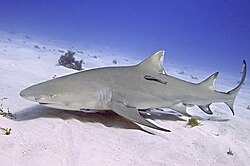Carcharhinidae
Carcharhinidae, also known as the requiem sharks, is a family of sharks in the order Carcharhiniformes.
| Carcharhinidae | |
|---|---|

| |
| A bull shark, Carcharhinus leucas | |
| Scientific classification | |
| Kingdom: | |
| Phylum: | |
| Class: | |
| Order: | |
| Family: | Carcharhinidae
|
There are currently 60 species of requiem sharks which are grouped into 12 genera. Some of the most familiar species in this family are the lemon shark, the blue shark, the tiger shark, the bull shark, and the whitetip reef shark.
Requiem sharks are found in temperate and tropical oceans, and many species are worldwide. Some live in the open ocean (oceanic whitetip shark), while some live in freshwater rivers and lakes (bull shark).[1]
All species of requiem sharks have a head of normal shape. Their eyes have a nictitating (winking) membranes. They have caudal fins with the upper lobe being larger than the lower but not very long, two spineless dorsal fins, the first one usually much larger than the second in most of the Atlantic species, an anal fin, a caudal peduncle which doesn't have lateral keels, and sharp, bladelike teeth with a single cusp. [2]
Almost all species of requiem sharks have a similar diet of fish, octopus, marine mammals and seabirds. Since they look similar, it is usually hard to tell one species from another.[3]
Evolutionary history
The oldest member of the family is from the early Cretaceous of France.[4] Only a few examples of the group are known from before the beginning of the Cenozoic.[5] Modern carcharinid sharks have extensively diversified in coral reef habitats.[6]
Genera
Carcharhinidae Media
Spinner shark, Carcharhinus brevipinna, from the Gulf of Mexico
Galapagos shark, Carcharhinus galapagensis
Lemon shark, Negaprion brevirostris, at Tiger Beach, Bahamas
Blue shark, Prionace glauca
References
- ↑ "Facts about Requiem Sharks(Carcharhinidae)-Encyclopedia of Life". eol.org. Retrieved 22 June 2013.
- ↑ "Requiem sharks, family Carcharhinidae". gma.org. Retrieved 22 June 2013.
- ↑ "BBC Nature-Requiem sharks videos,news,and facts". bbc.co.uk. Archived from the original on 27 June 2013. Retrieved 22 June 2013.
- ↑ Guinot, Guillaume; Cappetta, Henri; Adnet, Sylvain (March 2014). "A rare elasmobranch assemblage from the Valanginian (Lower Cretaceous) of southern France". Cretaceous Research. 48: 54–84. doi:10.1016/j.cretres.2013.11.014.
- ↑ Gates, Terry A.; Gorscak, Eric; Makovicky, Peter J. (2019-01-22). "New sharks and other chondrichthyans from the latest Maastrichtian (Late Cretaceous) of North America". Journal of Paleontology. 93 (3): 512–530. doi:10.1017/jpa.2018.92. ISSN 0022-3360. S2CID 198159821.
- ↑ Sorenson, L.; Santini, F.; Alfaro, M. E. (August 2014). "The effect of habitat on modern shark diversification". Journal of Evolutionary Biology. 27 (8): 1536–1548. doi:10.1111/jeb.12405. PMID 24890604. S2CID 27980093.
- ↑ "Fish Identification". fishbase.org. Retrieved 22 June 2013.













